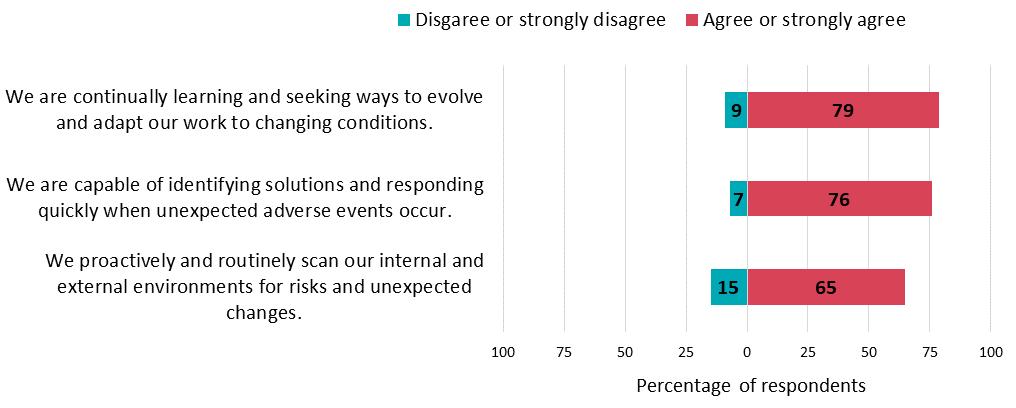As institutions and IT units increasingly focus on building resilience, leadership training and cross-unit collaboration will be critical for success. Resilience in higher education as a whole will depend on greater equity across institutions.

EDUCAUSE is helping institutional leaders, technology professionals, and other staff address their pressing challenges by sharing existing data and gathering new data from the higher education community. This report is based on an EDUCAUSE QuickPoll. QuickPolls enable us to rapidly gather, analyze, and share input from our community about specific emerging topics.Footnote1
The Challenge
As institutions of higher education emerge from the COVID-19 pandemic, they must balance renewed optimism for the future with readiness for other crises on the road ahead. They must improve their capabilities for anticipating, responding to, and adapting to continued changes in the higher education landscape. How might institutions and technology leaders not only improve these capabilities but also develop resilience to better manage future crises and change and be better positioned to thrive and achieve their mission regardless of what comes next?
The Bottom Line
Respondents rated their central IT unit's resilience more favorably than their institution's resilience. However, even those in the IT unit would benefit from expanding their understanding and practices of resilience as a way to move beyond "response" and toward a focus on anticipating and adapting to crises and long-term change. Leaders will need training and support to more effectively lead their institutions through resilience efforts, and unequal resilience across institutions will need to be addressed in order to build resilience for higher education as a whole.
For the purposes of this QuickPoll, we provided respondents with the following preliminary definition of resilience: "An organization's ability to anticipate, respond to, and adapt to change or disruption, enabling the organization to thrive and achieve its mission."
The Data: Institutional and Central IT Resilience
The IT unit may be more resilient than the institution. Asked to rate the resilience of both their institution and their central IT unit, respondents rated their central IT unit more favorably than their institution (see figure 1). Just over a third (36%) of respondents reported that their central IT unit is "extremely" resilient, compared with only 18% of respondents who reported the same for their institution.

Similarly, when asked whether strategic priorities at both the institution and the central IT levels were focused on becoming more resilient, respondents were more likely to respond in the affirmative for their central IT unit (63%) than they were for their institution (50%) (see figure 2).

Taken together, these findings suggest, first, that at some institutions, cultivating resilience (much like other institutional capabilities) may be a siloed effort isolated to certain units or departments, leading to a lack of awareness across campus. The findings also suggest, second, that IT professionals may have a role to play in helping lead resilience efforts for their larger institution. Technology leaders might take stock of the things they are already doing and learning about resilience, determine which of these activities other units and stakeholders at their institution may benefit from, and take steps to coordinate and communicate their resilience work with those other units and stakeholders.
When it comes to resilience, there are Haves and Have-Nots. Size and resources matter in helping institutions weather and even thrive in the face of adversity and change. Institutions with larger teams and more staff may have an easier time maintaining central functions and operations in the midst of disruption, and those with more financial resources likely have deeper reserves for outlasting economic downturns and financial loss.
Indeed, among respondents at our largest institutions (15,000 or more student, staff, and faculty FTE), a full 85% rated their institution as being "moderately" or "extremely" resilient. Among respondents at all other institutions, that figure drops to only 62%. Interestingly, this pattern does not hold for ratings of central IT resilience, which remains consistent across institution size.
Have we learned to be resilient through the COVID-19 pandemic? When asked to describe a recent example of resilience at their institution, the vast majority of respondents cited the COVID-19 pandemic. Certainly most institutions over the last several years have had to learn to be more resilient through the rapid migration of courses and student services online, the implementation of new health screening and safety measures, and the widespread adoption of remote and hybrid work models, among other unanticipated needs.
Yet as one respondent noted, "Responding to crisis is the low bar of strategic planning. . . . It's harder to align and prioritize for an unknown future." Indeed, as EDUCAUSE is currently conceiving the idea of resilience, developing this capability involves more than just crisis response. It also requires an ability to anticipate what's next and to adapt, over the long term, to changes in the institutional environment. Given this broader conception, we can see that many institutions still have far to go in building their resilience, even as they emerge from the pandemic nimbler and wiser.
The Data: The Attributes of Resilience
Actions are lagging behind values. Asked to rate their agreement or disagreement with a series of resilience attributes at their institution, a strong majority of respondents agreed that they understand and use their institution's vision, mission, and values (87%) and that their institution is characterized by positive values, attitudes, and behaviors (75%) (see figure 3). However, in other more specific and concrete areas of practice such as leadership, resource allocation, and continuous learning and improvement, respondents expressed noticeably lower levels of agreement.

Leaders matter, but they may be unprepared. Leaders are critical for the success of resilience efforts at the institution, not only in helping set the vision and values and culture that serve as the foundations for resilience but also in driving strategic planning and making key decisions that help build resilience. Yet among all the resilience attributes listed in the QuickPoll, respondents were least likely to agree that their "Institutional leaders are trained and equipped to lead under a range of conditions and circumstances" (39%).
This need for leadership was reinforced in the respondents' open-ended comments about the improvements that would be most important for institutional resilience. Their comments highlighted "vision and leadership," "training management to lead staff," and "proper leadership to motivate workers and implement change" as priorities for their institution.
Cross-institution coordination is key, but it may be lacking. Resilience is an institution-wide effort grounded in collaboration and shared vision, and yet the attribute "Institutional units and departments coordinate and communicate well" received the second-lowest level of agreement (42%) from respondents. When asked more specifically which units were contributing to integrate institutional resilience efforts (see figure 4), respondents clearly emphasized that some units (i.e., IT, Cybersecurity, Facilities, Risk, and Emergency management) were more involved than others. Another 21% of respondents indicated that their institution doesn't have an integrated approach to resilience at all.

The IT unit responded, but has it anticipated and adapted? If central IT units have done nothing else over the last several years, they have responded—to sudden shifts to online learning and work, to new technology needs around health and safety, and to a host of other pandemic-era demands that have helped elevate the strategic and operational importance of technology to their institution's mission.
In many of their open-ended comments, QuickPoll respondents shared examples of the IT unit's resilience as response. IT units have successfully resolved unexpected power or network outages. They've pivoted to make unanticipated systems changes or to adopt entirely new systems to meet emerging needs at their institution. All of these successes, though impressive, highlight IT units' capabilities in responding to crises or unexpected needs. Missing from respondents' examples are stories that would demonstrate IT units' ability to anticipate crises or adapt to longer-term changes.
When asked about their level of agreement or disagreement with several statements about their central IT unit's resilience—specifically focused on the degree to which their unit anticipates, responds, and adapts (see figure 5)—respondents expressed higher levels of agreement with their IT unit's capabilities in responding and adapting and slightly lower levels of agreement about their unit's capabilities in proactively anticipating risks and changes.

Common Challenges
Resilience is more than crisis response. As institutional leaders' understanding of and planning for resilience advance in the years ahead, they will need to broaden their resilience efforts beyond the ability to respond to crisis. Maintaining a narrower conception of resilience as response places the onus squarely on the continued ability to quickly respond to and weather future crises while it limits opportunities to anticipate and thrive through those crises.
Capabilities in foresight thinking and scenario planning, for example, may help focus institutional planning and decision-making on potential risks and opportunities and could better position the institution to be more proactive and less reactive. Ongoing assessment and continuous improvement of core functions and operations will help the institution evolve and remain relevant to the shifting needs of industry and demands from students.
Resilience is more than one unit's responsibility. As long as resilience efforts remain siloed within or relegated to certain units or departments, institution-wide efforts to build resilience will be stalled or diminished in their efficacy. As institutions develop their resilience plans, effective cross-unit coordination and communication must be an explicit and core focus of those plans.
Promising Practices
Building resilient leaders for resilient institutions. While resilience is everyone's responsibility, institutional leaders play a critical role in setting the vision for resilience efforts and in demonstrating the principles of resilience through their actions and decisions. Technology leaders should consider starting with the EDUCAUSE Professional Pathways to determine which competencies they and their teams may need to develop and which resources and services might be most beneficial in supporting resilience efforts at their institution.
Establishing institutional equity for higher education resiliency. What is required for the industry of higher education as a whole to be resilient? Among other things, this resiliency requires that all institutions across regions and sizes and types, and regardless of wealth and prestige, are equipped with resources and strategies to help build resilience and position themselves to thrive and achieve their mission.
Equitable resilience may require strategies for supporting under-resourced institutions, particularly to help mitigate disruptions that adversely affect institutions with fewer operational and/or financial resources. But as we broaden discussions of resilience beyond mere response to include anticipation and adaptation, cross-institutional efforts like EDUCAUSE Connect and the CLIR/EDUCAUSE Leading Change Institute can help leaders develop and share innovative ideas and build diverse peer networks that foster mutual support and learning.
All QuickPoll results can be found on the EDUCAUSE QuickPolls web page. For more information and analysis about higher education IT research and data, please visit the EDUCAUSE Review EDUCAUSE Research Notes topic channel, as well as the EDUCAUSE Research web page.
Note
- QuickPolls are less formal than EDUCAUSE survey research. They gather data in a single day or two, instead of over several weeks, and allow timely reporting of current issues. This poll was conducted on August 1–2, 2022, consisted of 12 questions, and resulted in 126 complete responses. Poll invitations were sent to participants through the EDUCAUSE Connect platform to groups focused on IT leadership and management; we are not able to associate responses with specific institutions. Our sample represents a range of institution types and FTE sizes, and most respondents (98%) represented U.S. institutions. Jump back to footnote 1 in the text.
Mark McCormack is Senior Director of Research and Insights at EDUCAUSE.
© 2022 Mark McCormack. The text of this work is licensed under a Creative Commons BY-NC-ND 4.0 International License.
